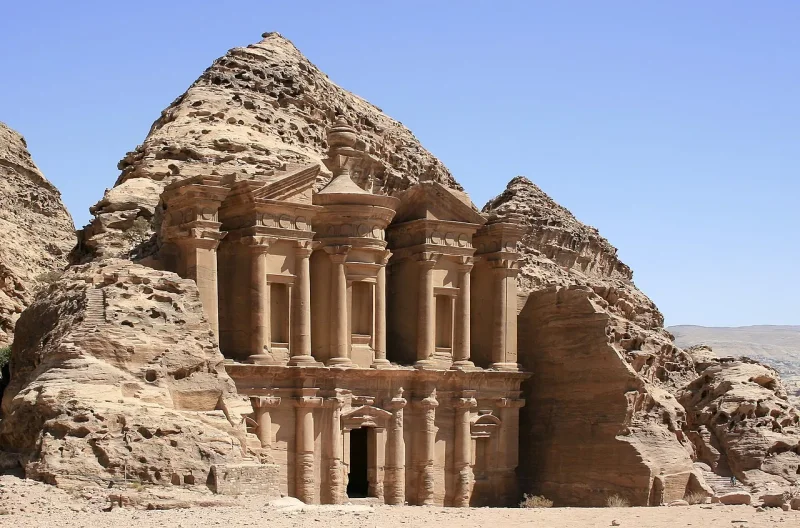The Enigmatic Charm of Petra
Petra, often referred to as the "Rose City" due to the color of the stone from which it is carved, is a remarkable archaeological site located in southern Jordan. This ancient city was the capital of the Nabataean Kingdom and is renowned for its breathtaking architecture and advanced water conduit system. Petra's allure is not only due to its historical significance but also its mysterious beauty, which has captured the imagination of many. The city is a UNESCO World Heritage site and one of the New Seven Wonders of the World.
The site was virtually unknown to the Western world until it was rediscovered by Swiss explorer Johann Ludwig Burckhardt in 1812. Since then, Petra has become a symbol of Jordan and a popular tourist destination, attracting visitors from around the globe. The city's dramatic landscapes and intricate rock-cut architecture have made it a favorite setting for films, most notably the 1989 movie "Indiana Jones and the Last Crusade." This film brought Petra to the forefront of global pop culture, adding to its mystique and allure.
Architectural Marvels of Petra
The city's most iconic structure, Al-Khazneh, also known as "The Treasury," is a stunning example of Nabataean engineering and artistry. Carved directly into the vibrant sandstone cliffs, this monumental façade is believed to have been constructed in the 1st century AD as a mausoleum for a Nabataean king. Its intricate Hellenistic design, complete with Corinthian columns and detailed sculptures, highlights the cultural syncretism that characterized Petra's architectural style. Al-Khazneh stands as a testament to the advanced skills of the Nabataean builders.
Petra's architecture extends beyond The Treasury, with a vast array of tombs, temples, and amphitheaters that demonstrate the city's importance as a thriving commercial hub. The Monastery, another significant structure, is larger than The Treasury and offers sweeping views of the surrounding landscape. Visitors can explore the many rock-cut tombs and climb the steep trails that lead to Petra's high places, providing a glimpse into the lives of the Nabataeans who once inhabited this bustling city. Each structure tells a story of a civilization that was both innovative and resilient.
The Cultural Significance of Petra
Petra was a melting pot of cultures, serving as a crossroads for trade routes connecting Arabia, Egypt, and the Mediterranean. This strategic location allowed the Nabataeans to amass wealth and influence, as they controlled the trade of frankincense, myrrh, and spices. The city's cultural significance is evident in its diverse architectural styles, which incorporate elements from Greek, Roman, Egyptian, and Mesopotamian traditions. Petra's ability to blend these influences into a cohesive and harmonious whole speaks to the sophistication of Nabataean society.
Beyond its architectural achievements, Petra was a center of cultural exchange and innovation. The Nabataeans developed a complex water management system, utilizing dams, cisterns, and aqueducts to harness the scarce desert resources. This ingenuity allowed the city to flourish in an arid environment, sustaining a large population and facilitating its role as a major trading hub. Petra's legacy as a center of culture and commerce continues to be studied and celebrated, highlighting its enduring impact on the region and beyond.
Petra in Modern Pop Culture
Petra's dramatic landscapes and ancient allure have captured the imagination of filmmakers and storytellers worldwide. Its most famous appearance in modern pop culture is in "Indiana Jones and the Last Crusade," where it served as the backdrop for the film's climactic scenes. The movie's portrayal of Petra as the resting place of the Holy Grail has contributed to the site's legendary status, sparking interest and curiosity among audiences globally. This cinematic debut introduced Petra to a new generation, cementing its place in the popular imagination.
Beyond cinema, Petra has been featured in numerous documentaries, books, and video games, further solidifying its role as a cultural icon. Its enigmatic beauty and historical significance make it an ideal setting for stories of adventure and exploration. The city's portrayal in various media has helped raise awareness about the importance of preserving cultural heritage sites. Petra's presence in modern pop culture serves as a reminder of the timeless appeal of ancient wonders and their ability to inspire awe and wonder across different cultures and generations.
Preserving Petra for Future Generations
As a UNESCO World Heritage site, Petra is recognized for its outstanding universal value and is protected under international conventions. However, the city faces numerous challenges, including erosion, tourism-related damage, and climate change.

_800.webp)

